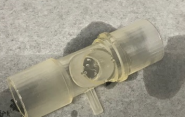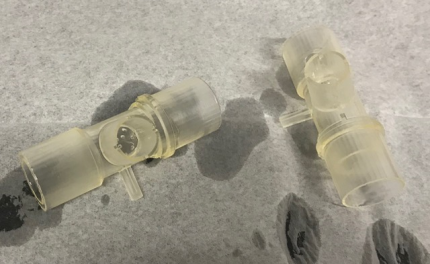Small but Critical Ventilator Parts Run Low, so Researchers Make Their Own

The need for ventilators in response to COVID-19 has been well publicized, but the single-use parts that comprise these machines has also been running critically low in hospitals. To ensure that Yale’s healthcare professionals remain in stock, researchers have taken to making their own.

“We’re not just running out of ventilators, we’re running out of all the disposable components, like the tubing and connectors that help us bring the oxygen and air to the patients to help them breathe,” said Daniel Wiznia, assistant professor of orthopaedic surgery and mechanical engineering & materials science. “There’s all these different little connectors that help us administer medication and help us connect certain tubes together so we can properly humidify the air or properly deliver medication to the patient's lungs - and we’re running low on them.”
To make sure that there’s a steady supply, Wiznia’s part of a team that developed their own parts. The project is one of the efforts to come out of the Coalition for Health Innovation in Medical Emergencies (CHIME), a multidisciplinary group that came together in March to address innovations related to COVID-19. So far Yale-New Haven Hospital hasn’t had to use the new supply of parts, but having them available offers some assurance.
“You can imagine every hospital in the country is trying to get a hold of these parts as well, and they’re all on incredible backorder,” he said.
Wiznia said professionals in the respiratory therapy department identified the most critical components. Using computer-aided design to draw their structures, these designs were then sent to James Nikkel, associate director for instrumentation and education at the Wright Laboratory, who then made exact measurements of these parts to recreate them with the lab’s 3D printers. Nikkel noted that because of the way the original parts were manufactured, the 3D printed versions aren’t always exact copies. He held up one of the connectors as an example.
“It’s super clever but it’s not something that can be printed, so you have to look at it and say what are the functional elements?” he said. “We essentially translate it into a model that you can print.”
Eight ventilator parts were judged to be in particularly short supply, including connectors and tubing (15 to 22 millimeters). “Some of them will help us administer nebulizer or inhaler treatments to patients and some allow us to filter the air that we're delivering to the patient,” Wiznia said.
After making and testing the prototypes at Yale, the parts have since been sent to local company Interpro to manufacture on a larger scale following FDA regulations. The Deep River company has supplied a batch of these parts to Yale-New Haven Hospital.
“We have the capacity to produce them ourselves but we felt that from a safety standpoint, it made more sense to have a company that produces medical-grade equipment,” Wiznia said.

